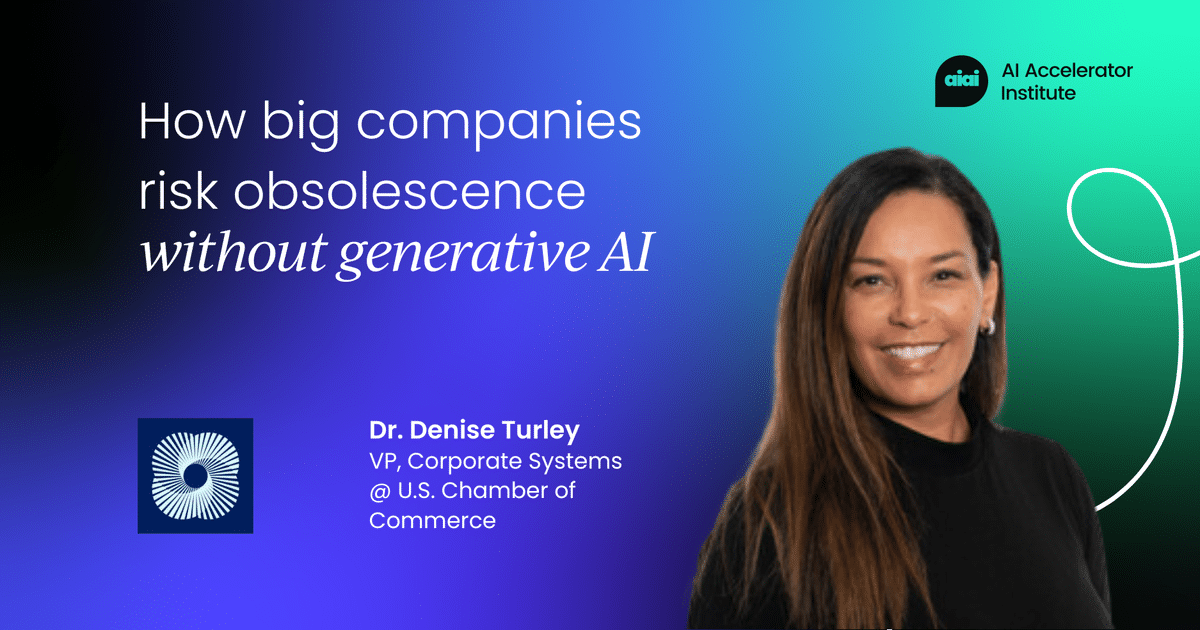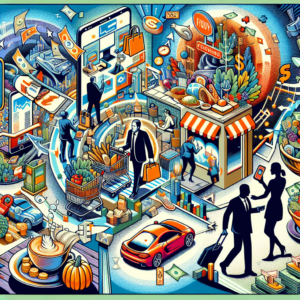Generative artificial intelligence has ceased to be a futuristic concept to become a transformative force that is reshaping the most innovative industries of today. Companies like Klarna and J.P. Morgan are taking bold steps by integrating generative AI into their operations, challenging the status quo and enabling unprecedented efficiency and creativity.
This shift is not just an incremental improvement; it is a paradigm shift that allows organizations to automate complex processes, generate creative content, and make data-driven decisions more effectively than ever before. However, despite its clear potential, many large companies are hesitant, caught in Clayton Christensen’s “Innovator’s Dilemma”. They are torn between the safety of their profitable legacy systems and the uncertain yet promising path of investing in disruptive technologies such as generative AI. For these companies, the risk is not just falling behind their competitors; it is the danger of becoming irrelevant in a landscape that rewards agility and punishes complacency.
In today’s accelerated market, clinging to comfort zones can become a liability. Companies that cling to outdated approaches while ignoring the winds of change are playing a dangerous game, one that could end with them being overtaken, surpassed, and ultimately pushed out of the market.
Christensen’s “Innovator’s Dilemma” illustrates how companies often lose their advantage by focusing on existing products while ignoring larger shifts. Generative AI represents one of these shifts, transforming industries with innovations that improve efficiency and open up new possibilities. Klarna’s recent decision to move away from established SaaS platforms like Salesforce and Workday exemplifies this transformation. By developing an internally-driven AI solution, they not only replicate but surpass decades of customization and workflow automation offered by industry giants. This bold move challenges the narrative of SaaS “stickiness” and highlights how companies that remain in their comfort zones risk being overtaken by more agile competitors.
Consider how Blockbuster, a giant in its time, ignored the rise of digital streaming while Netflix evolved from a niche DVD rental service to a streaming powerhouse. Companies that do not adopt generative AI today face a similar fate. Disruptive technologies do not pause for established players: they redefine industries and leave behind those who cannot or will not adapt.
Malcolm Gladwell’s book “The Tipping Point” emphasizes how transformative changes often start subtly, with small almost imperceptible shifts that eventually reach a critical mass. Many companies entrenched in their comfort zones overlook these initial signs, dismissing them as inconsequential until the tipping point is reached and transformation becomes inevitable. Striking a balance between current customer needs and innovation is essential for long-term survival.
While it is important to address current customer needs, it is equally crucial for companies to anticipate future market demands. Generative AI technologies often start small, catering to niche markets or solving problems not immediately apparent to conventional customers. However, as these technologies evolve, they can redefine entire industries. Gladwell discussed how niche innovations, initially overlooked or even ridiculed, can suddenly become the next big thing when they reach a tipping point, rapidly gaining acceptance and disrupting established markets.
Having a vision for generative AI is only part of the equation; the true test lies in execution, where costs and complexity can become formidable barriers. Implementing generative AI requires a multi-year comprehensive strategy. The expenses associated with AI software, infrastructure, and staff training are significant obstacles that can deter many organizations. According to a 2023 McKinsey & Company report, companies investing in AI can expect to allocate 20-30% of their IT budgets to AI initiatives.
Klarna’s success was not just about adopting a new technology; it involved reengineering its tech stack from scratch and embracing standardization to reduce complexity. This approach required significant commitment but resulted in a more agile and cost-effective system. Their experience demonstrates that while the barriers to implementing AI are real, they can be overcome with a strategic long-term vision.
Integrating generative AI is not just about acquiring technology: it is about embedding it in the organizational DNA and aligning it with the business’ strategic objectives. This involves substantial investments not only in technology but also in people and processes, requiring a commitment to long-term change rather than short-term fixes. Organizations that hesitate due to these initial obstacles risk falling behind as others recognize the potential and reach the tipping point where generative AI shifts from experimental to essential.
Established organizations often value stability and incremental improvements. GenerativeAI challenges these norms, requiring companies to rethink how value is created and delivered. The psychological barrier, the fear of undermining one’s own success, can paralyze decision-making and lead companies to stick to what is safe rather than exploring new horizons.
Despite these challenges, companies like J.P. Morgan are successfully navigating this complex landscape. J.P. Morgan has launched an AI-powered chatbot for its research analysts, streamlining access to information and data across the organization. This initiative reflects a broader strategy to embed generative AI within the company’s operations, improving decision-making and fostering a culture of agility and innovation. By taking a proactive approach, J.P. Morgan is not only embracing generative AI but transforming how business is done, setting a benchmark for other companies on how to successfully integrate AI.
While measuring success in generative AI can be challenging due to the early nature of the technology, the initial benefits are already reshaping business operations. A significant obstacle is establishing clear ROI and KPIs, as many AI projects are still in exploratory stages. However, a Deloitte survey found that over 50% of early AI adopters reported a positive return on their investment. Leaders must invest with a long-term vision, understanding that while specific metrics may still be evolving, the transformative impact of AI is increasingly undeniable.
As established companies adapt, more agile startups are often better positioned to rapidly capitalize on the potential of generative AI. Without the burden of legacy systems and entrenched processes, these newcomers can experiment, adapt, and scale AI initiatives more effectively. Companies like Writesonic and Gamma.app are leveraging generative AI to reshape industries such as content creation and corporate communication. They exemplify how agile players can outperform larger and slower competitors.
Klarna’s bold strategy does not only signify a shift for one company; it poses critical questions for the entire SaaS industry. If AI enables companies to replace decades of deep integration with more agile and personalized solutions, the traditional “stickiness” of SaaS platforms is under threat. This development forces CIOs and IT leaders to reconsider their reliance on established vendors and explore the potential of internally-driven AI solutions. The financial stakes are high, as companies could save millions annually by reducing dependence on costly SaaS products. According to Gartner, organizations can reduce operational costs by 20-30% by 2025 through AI-driven efficiencies. Klarna’s example could be the tipping point that accelerates a broader movement away from traditional SaaS, underscoring the urgent need for companies to adapt or risk obsolescence.
As companies adopt generative AI, it is crucial to address ethical and social considerations. Issues such as data privacy, security, and algorithmic bias can pose significant risks if not managed properly. A 2022 PwC survey revealed that over 55% of consumers are concerned about how companies use their personal data. Implementing robust data governance policies and ethical guidelines is essential to build trust with stakeholders and ensure compliance with regulations such as GDPR.
Additionally, the impact of AI on the workforce cannot be ignored. While AI can automate routine tasks, it can also lead to job displacement. Companies must invest in retraining and upskilling their employees to work alongside AI technologies, fostering a culture of continuous learning and adaptation.
To move from theory to practice, companies must take deliberate steps to integrate generative AI into their operations. Here is how leaders can begin this transformative journey: garner executive support, conduct an AI readiness assessment, develop a strategic AI roadmap, initiate pilot projects, invest in talent and training, address ethical and governance considerations, leverage partnerships and collaborations, monitor and measure impact, and plan for long-term sustainability. By following this roadmap, companies can navigate the complexities of adopting generative AI, mitigate risks, and position themselves for long-term success in an increasingly AI-driven world.
The lessons of the “Innovator’s Dilemma” are clear: focusing solely on today’s successes without investing in disruptive technologies like generative AI is a risky bet. AI is not just another tool; it is a fundamental shift in how businesses operate. Companies that fully integrate generative AI into their operations will not only survive but thrive, setting the pace in their industries. In contrast, those who do not adapt risk facing the same fate as Blockbuster and BlackBerry: falling behind in an increasingly AI-driven world that rewards the bold and punishes the complacent.
via: MiMub in Spanish











